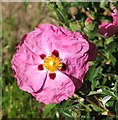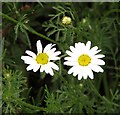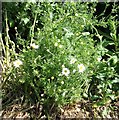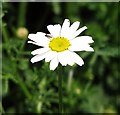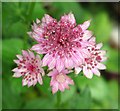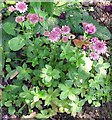1
Peony spec
The peony is named after Paean, who was a student of the Greek god of medicine, Asclepius. Zeus turned Paean into the peony to save him from the anger of Asclepius, who had become jealous of his student’s healing abilities.
Peonies are native to north Japan, parts of Asia, parts of North America and southern Europe. They prefer woodland habitats, but can also be found growing on mountainous terrain. There are numerous cultivated garden varieties.
Image: © Evelyn Simak
Taken: 23 May 2017
0.04 miles
2
Chamomile spec
Chamomile is one of the oldest favourites amongst garden herbs. In Egypt it was reverenced for its power to cure ague. The plant is also documented to have been used for calming frayed nerves and soothing various stomach problems, to reduce muscle spasms, and to treat several skin conditions.
Image: © Evelyn Simak
Taken: 23 May 2017
0.05 miles
3
Chamomile spec
Chamomile is one of the oldest favourites amongst garden herbs. In Egypt it was reverenced for its power to cure ague. The plant is also documented to have been used for calming frayed nerves and soothing various stomach problems, to reduce muscle spasms, and to treat several skin conditions.
Image: © Evelyn Simak
Taken: 23 May 2017
0.05 miles
4
Chamomile spec
Chamomile is one of the oldest favourites amongst garden herbs. In Egypt it was reverenced for its power to cure ague. The plant is also documented to have been used for calming frayed nerves and soothing various stomach problems, to reduce muscle spasms, and to treat several skin conditions.
Image: © Evelyn Simak
Taken: 23 May 2017
0.05 miles
5
Insect on flower
Image: © Evelyn Simak
Taken: 23 May 2017
0.05 miles
6
Jacob's Ladder (Polemonium caeruleum)
This plant is native to temperate aereas of Europe and Asia and also known as Greek valerian. It is apparently quite rare in the UK, where it is said to be growing at several locations on limestone cliff ledges in Yorkshire and localised places in Derbyshire. It used to be the only known member of its family until taxonimists decided to add a few more genera, currently including phox. The black dye produced by boiling the plant in olive oil is used for colouring grey hair. See > http://www.geograph.org.uk/photo/5405720 for a more detailed look of the flowers.
Image: © Evelyn Simak
Taken: 23 May 2017
0.05 miles
7
Masterwort (Astrantia spec)
Astrantia are herbaceous plants in the Apiaceae family and endemic to central, eastern and southern Europe and the Caucasus. They are commonly known as masterwort. The genus' name is derived from the Latin 'aster', meaning star, referring to the open star-shaped floral bracts of the plant. The garden variety depicted here is called Astrantia 'Roma'.
Image: © Evelyn Simak
Taken: 23 May 2017
0.05 miles
8
Masterwort (Astrantia spec)
Astrantia are herbaceous plants in the Apiaceae family and endemic to central, eastern and southern Europe and the Caucasus. They are commonly known as masterwort. The genus' name is derived from the Latin 'aster', meaning star, referring to the open star-shaped floral bracts of the plant. The garden variety depicted here is called Astrantia 'Roma'.
Image: © Evelyn Simak
Taken: 23 May 2017
0.05 miles
9
Masterwort (Astrantia spec)
Astrantia are herbaceous plants in the Apiaceae family and endemic to central, eastern and southern Europe and the Caucasus. They are commonly known as masterwort. The genus' name is derived from the Latin 'aster', meaning star, referring to the open star-shaped floral bracts of the plant. The garden variety depicted here is called Astrantia 'Roma'.
Image: © Evelyn Simak
Taken: 23 May 2017
0.05 miles
10
Masterwort (Astrantia spec)
Astrantia are herbaceous plants in the Apiaceae family and endemic to central, eastern and southern Europe and the Caucasus. They are commonly known as masterwort. The genus' name is derived from the Latin 'aster', meaning star, referring to the open star-shaped floral bracts of the plant. The garden variety depicted here is called Astrantia 'Roma'.
Image: © Evelyn Simak
Taken: 23 May 2017
0.05 miles


